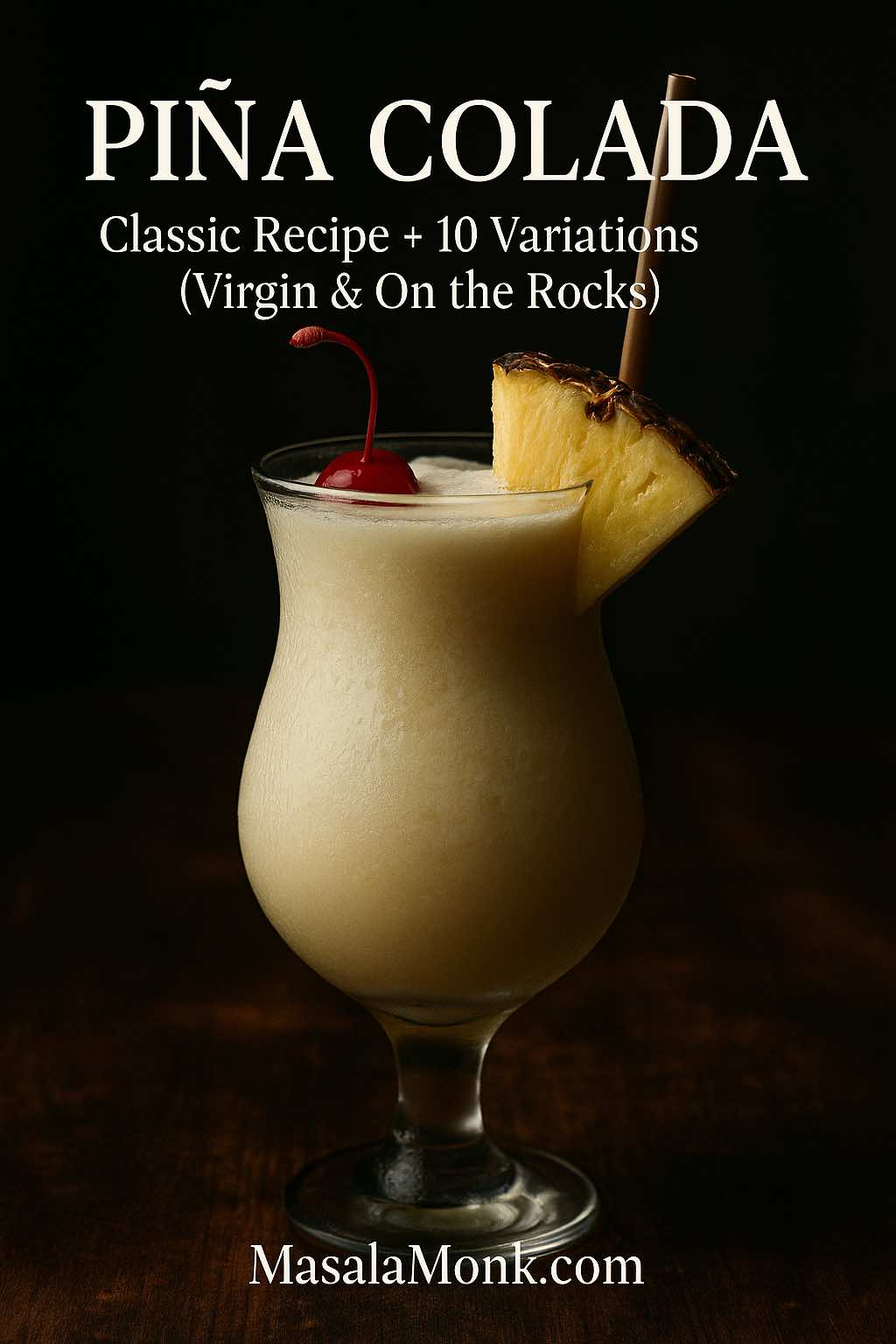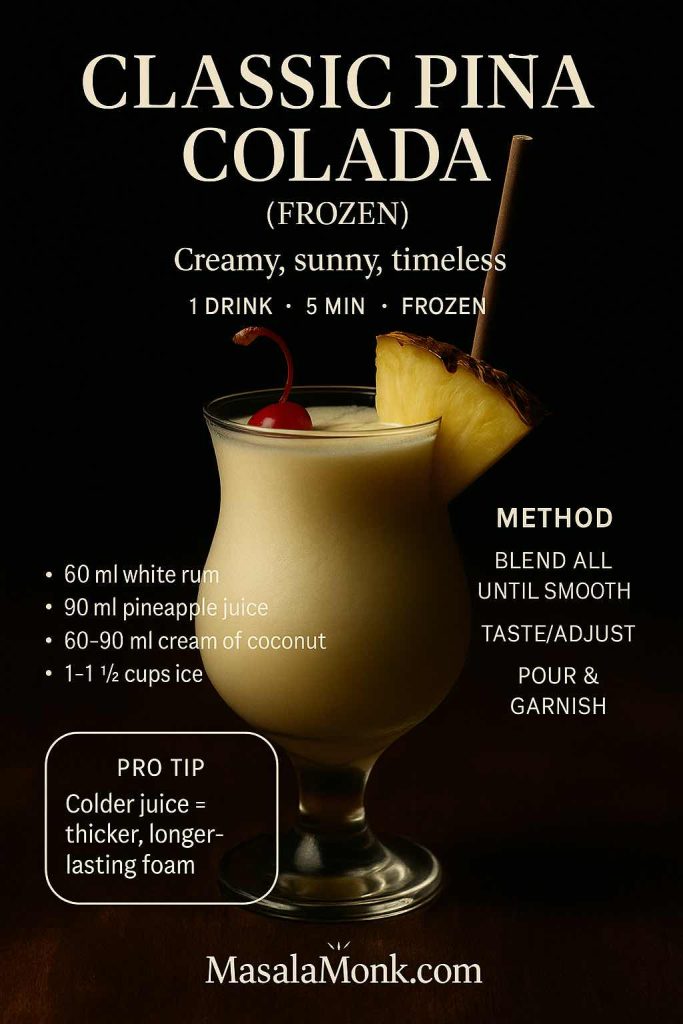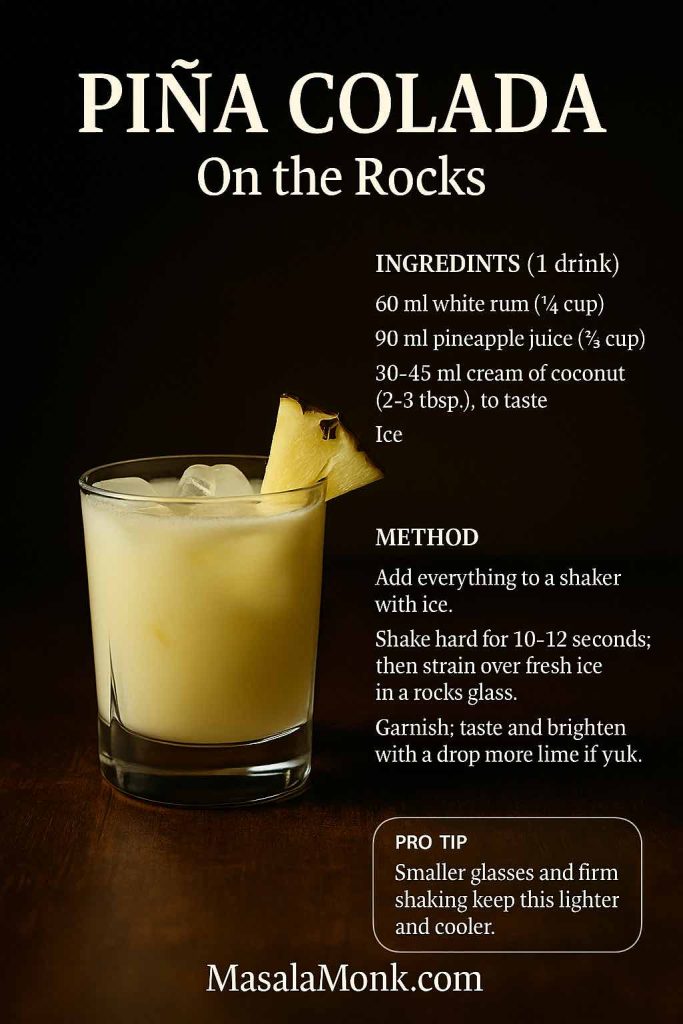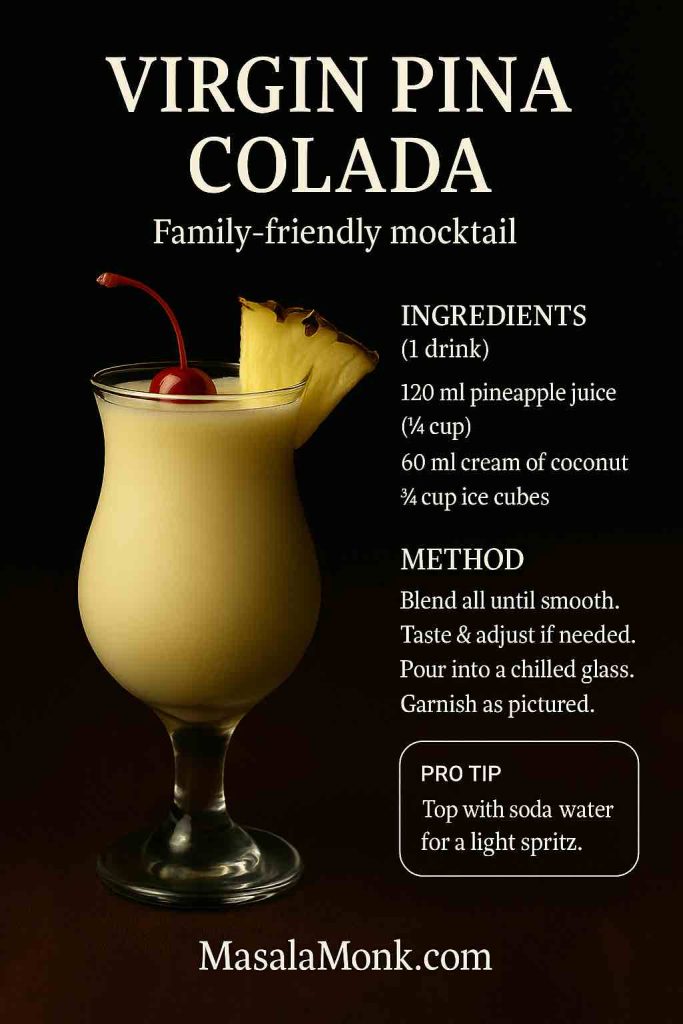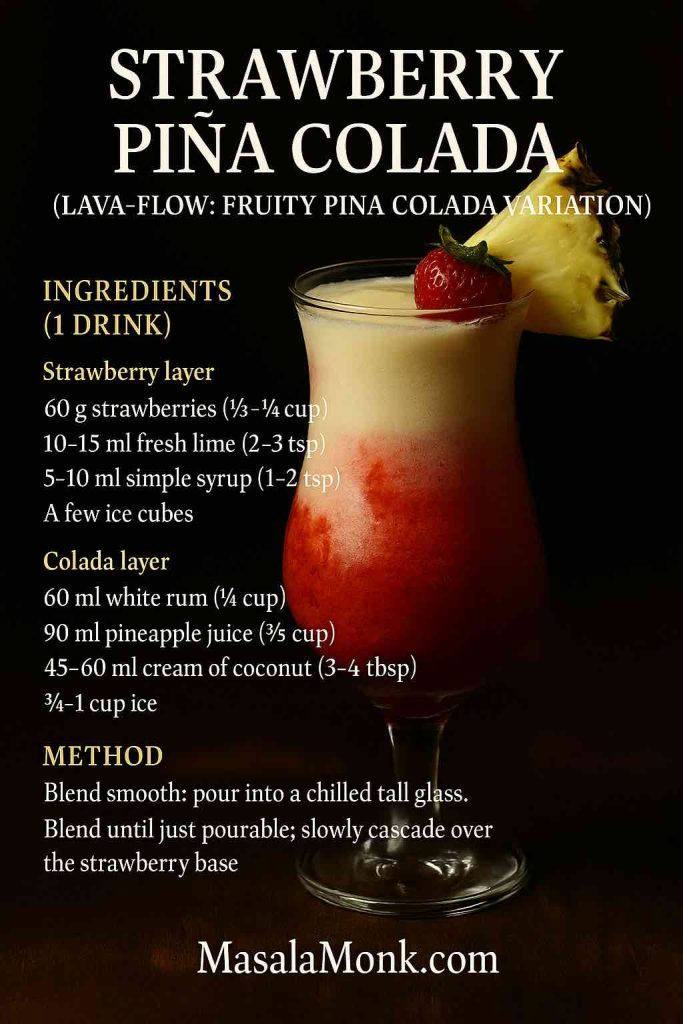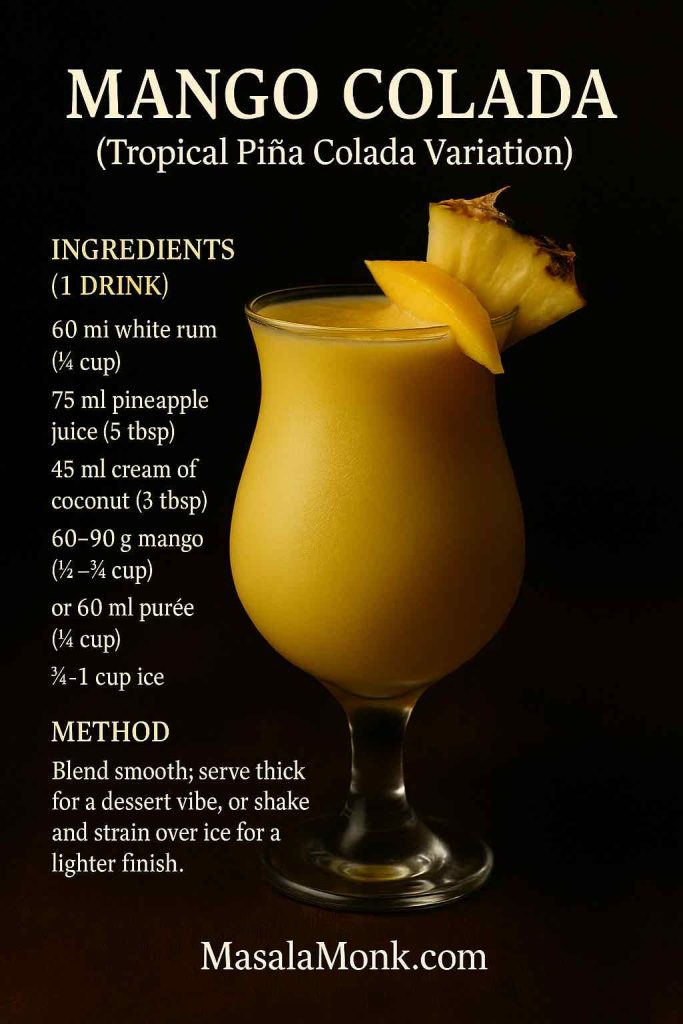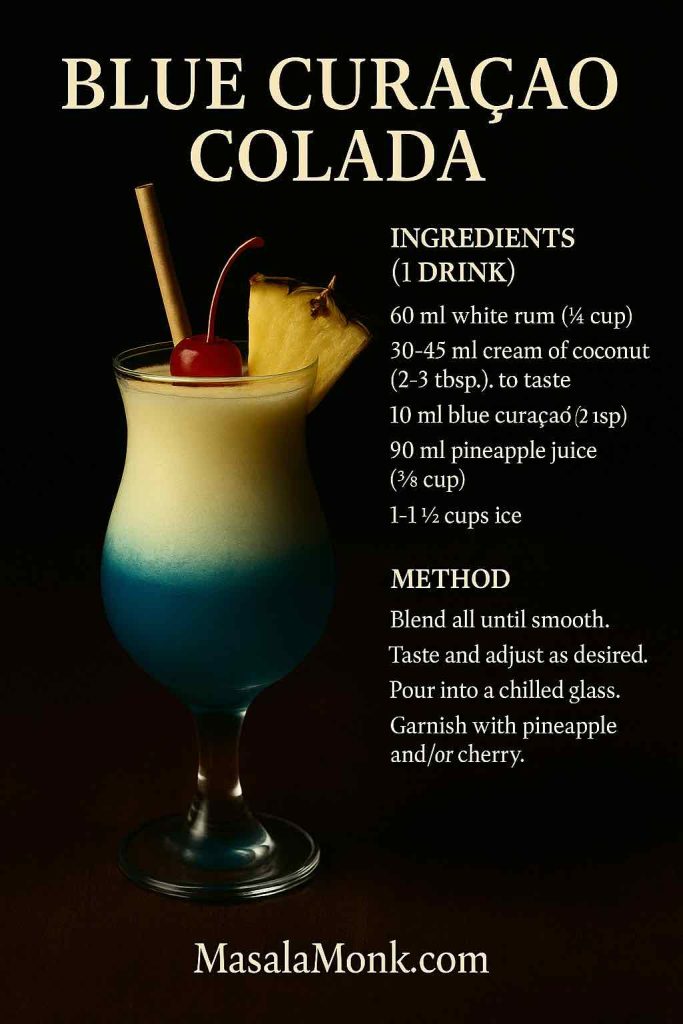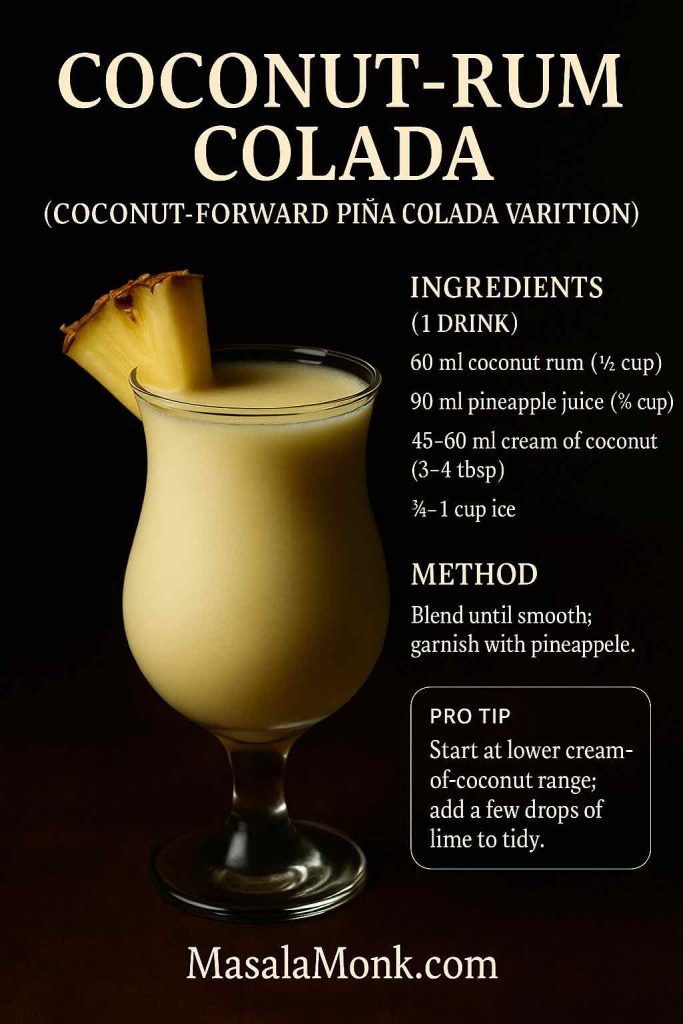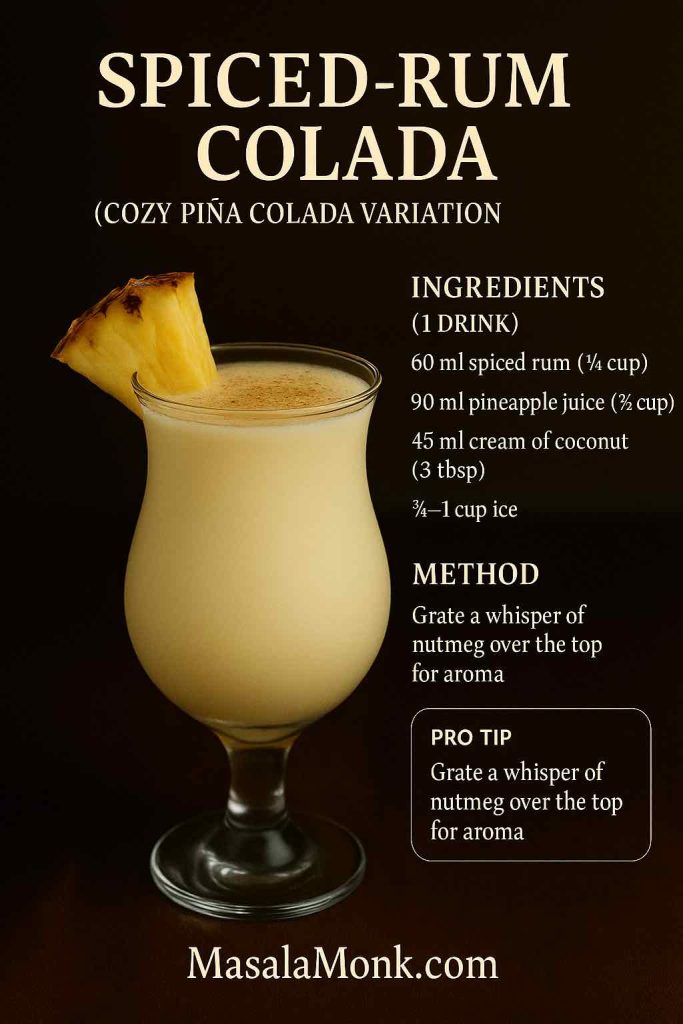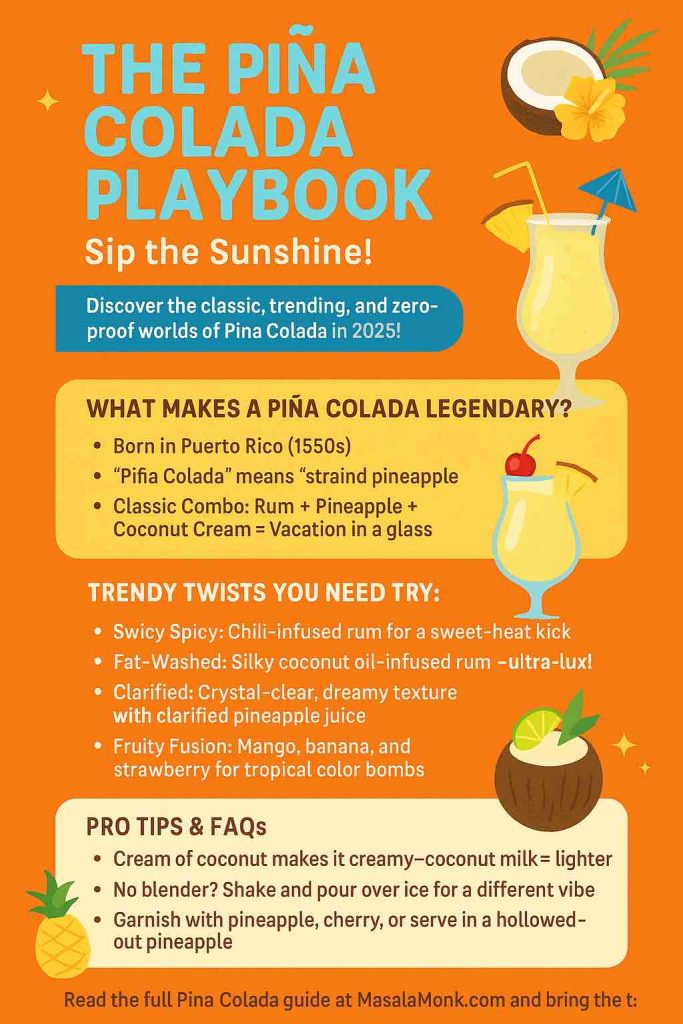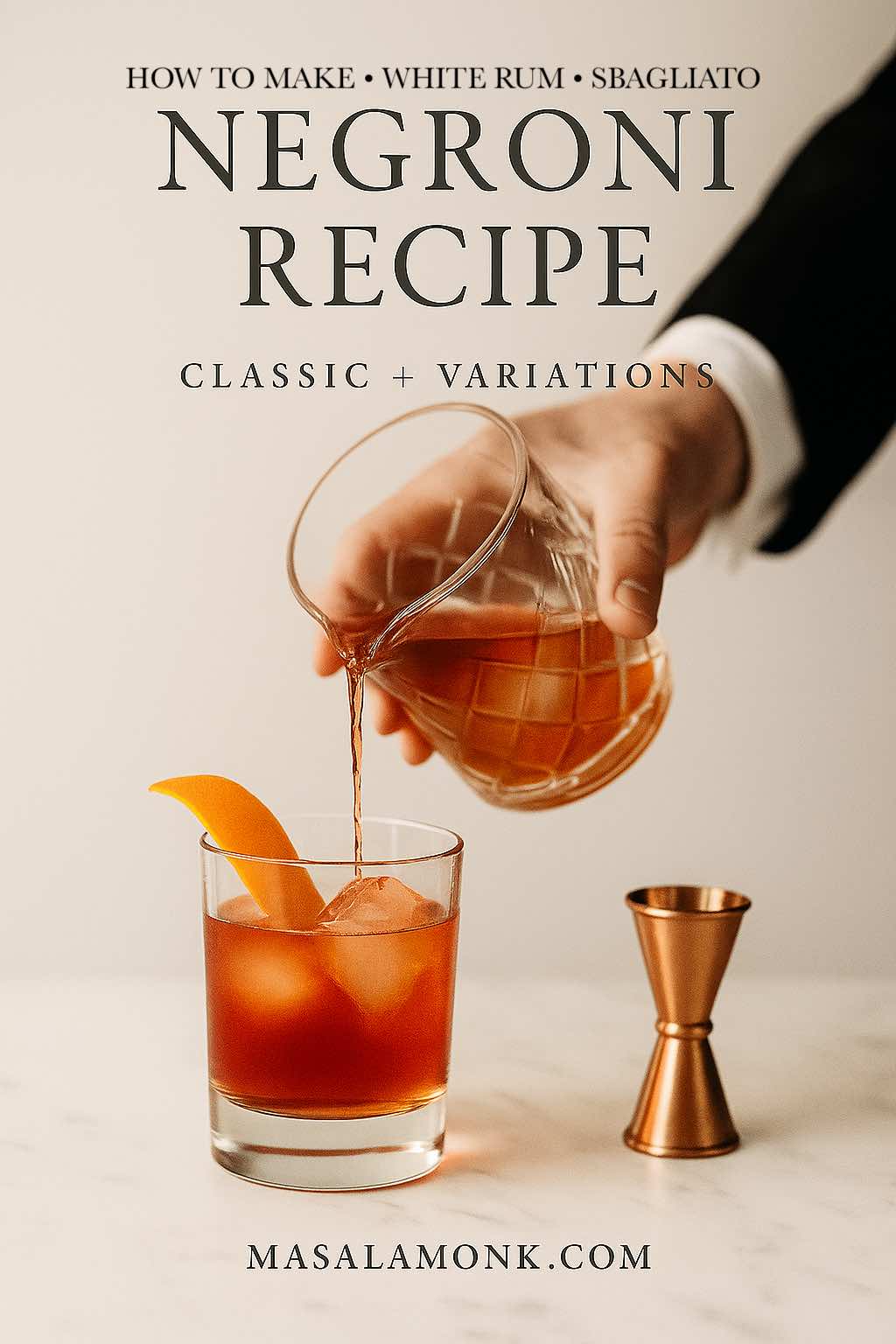
Some drinks are fashionable for a season; others become a ritual. The Negroni recipe belongs to the second camp—three equal parts, stirred until silk-smooth, brightened with orange oils, and served over clean, cold ice. Before we branch into the riffs everyone searches for, let’s calibrate to the standard so your palate has a reference point. The version codified by the International Bartenders Association matches what you’ll find on Campari’s own recipe page: 1 part gin, 1 part Campari, 1 part sweet red vermouth, stirred and garnished with orange. With that compass set, you can navigate anywhere.
Technique that makes a Negroni sing
Stirring is non-negotiable here. Shaking a Negroni will aerate and cloud it, muting those ruby facets and loosening structure more than you want. Building in a mixing glass full of dense, cold cubes gives you precise control over dilution, and that control translates directly into texture—the way the drink glides rather than tumbles. When you’re entertaining, large-format or clear cubes keep the drink crisp for longer; they also look beautiful in the glass and help you serve confidently through a long conversation. If you’d like a quick refresher on picking ice for different drinks, our primer on purpose-built cubes and crushed ice in long refreshers lays out the tradeoffs in plain terms—big cubes for slow melt, crushed for instant chill and a “vacation” vibe (see our note in Coconut Water Cocktails).
Because vermouth is wine, treat it like one. Once you crack a fresh bottle, keep it in the fridge and try to use it within about a month for peak flavor—this aligns with testing discussed by Serious Eats on vermouth storage—and while you can stretch to six or eight weeks without disaster, oxidation slowly flattens those herbs and spice notes (more on that from Liquor.com). A small mark on the label with the open date is a tiny habit that pays off in brighter cocktails: the case for refrigerating vermouth and a complementary reminder about the practical “use-by” window from Liquor.com.
Alright—glasses chilled, citrus ready, vermouth cold. Let’s make the drink you came for, then fan out into the variations people are actively searching for right now.
Also Read: How to Cook Perfect Rice Every Time (Recipe)
The classic Negroni recipe (your baseline)
Ratio: 1:1:1
Spec: 30 ml (1 oz) London Dry gin · 30 ml (1 oz) Campari · 30 ml (1 oz) sweet (rosso) vermouth
Method: Add to a mixing glass full of firm ice. Stir 20–25 seconds until the liquid looks glossy and the mixing glass is frosty. Strain over a single large cube in a rocks glass. Express a wide piece of orange peel over the top—aim the peel at the surface and squeeze to lay down aromatics—then drop it in.

Although the equal-parts recipe is deceptively simple, it’s also incredibly sensitive to temperature and melt. Consequently, colder starting ingredients behave better, and using a heavy-bottomed rocks glass keeps the drink cooler in hand. Moreover, up-front prep (pre-chilled glasses, cut peels, fresh big cubes) makes service smooth when you’re making more than one round. Similarly, if you enjoy tinkering, try the classic with contrasting gin styles: a juniper-forward London Dry for textbook snap, or a contemporary floral gin for a lifted, citrus-blossom top note. Express the orange peel cleanly either way—the oils knit the edges together and frame the bitterness.
Lastly, if you’re curious about the broader ecosystem of canonical specs, the IBA maintains a list of official classics worth exploring—your Negroni sits among them, and its whiskey cousin, the Boulevardier, is there as well: browse the IBA’s cocktail index.
Also Read: Homemade Hot Chocolate with Cocoa Powder Recipe
From the classic to the crowd’s favorites
Now that your baseline is calibrated, let’s walk the tree of variations. We’ll start with the ones readers look for most—White Negroni, Mezcal Negroni, Sbagliato & Spritz, Boulevardier (bourbon/rye/scotch), Rum & Kingston, Espresso Negroni, Dry/ Bianco—and then add a few seasonal or technique-driven paths. As we go, you’ll see a pattern: every riff pushes on one leg of the 1:1:1 triangle—base spirit, bitter, or sweet—then resolves the new shape with a compatible garnish or texture.
How to make White Negroni (equal parts; gentian brightness, citrus lift)
The White Negroni flips the color without losing the bitter-sweet tug-of-war. To do it, keep the equal-parts logic but swap components: gin stays; Campari becomes a pale gentian bitter (commonly Suze); sweet vermouth becomes a lighter, aromatic aperitif wine such as Lillet Blanc or Cocchi Americano.
Spec: 30 ml (1 oz) gin · 30 ml (1 oz) Suze · 30 ml (1 oz) Lillet Blanc or Cocchi Americano
Method: Stir and serve either up in a chilled coupe or down over a large cube; garnish with a grapefruit peel for a bright, floral lift.
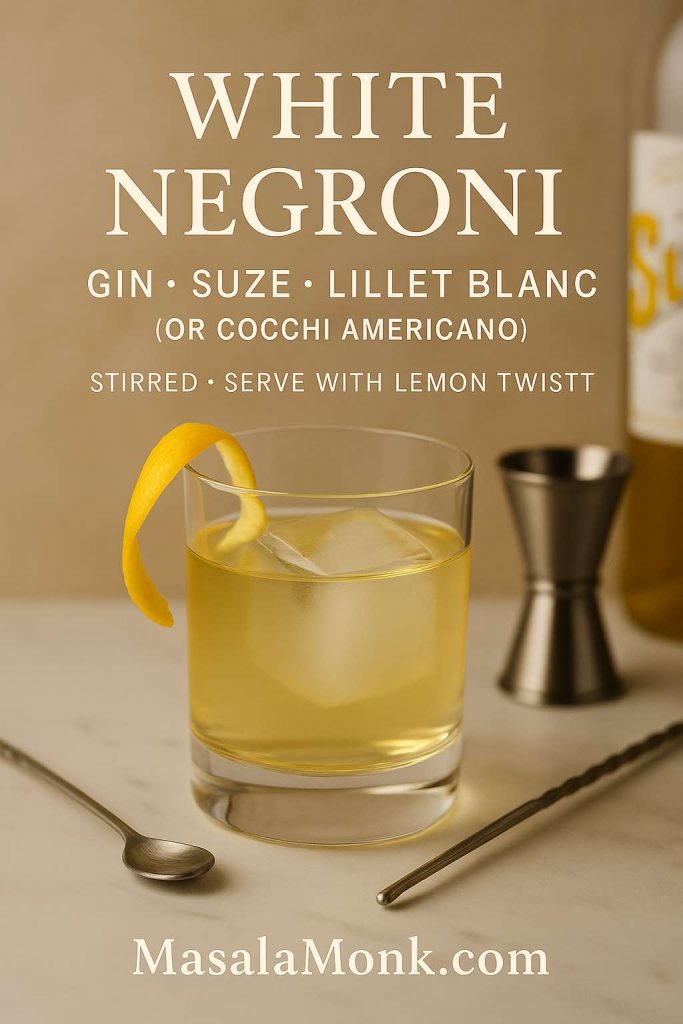
The drink’s modern origin is widely credited to Wayne Collins (early 2000s), and you’ll find both equal-parts and lightly adjusted versions in print. For a concise backgrounder and spec, have a look at WSET’s neat overview of contemporary Negroni twists, which also gives context to how bartenders keep reinventing this structure: three bold spins on a bitter classic.
Meanwhile, if bergamot is your love language, you may enjoy a tea-scented detour next: our iced-tea cocktail roundup includes an Earl Grey Negroni idea that blends refined citrus perfume with familiar bitterness—peek at the “Earl Grey Negroni” mention inside Earl Grey Elegance.
Also Read: Mango Martini + 5 Variants of Classic Cocktail
Mezcal Negroni Recipe (smoke threaded through ruby bitters)
Smoky, savory mezcal can be polarizing on its own; inside a Negroni, however, it becomes structure rather than spectacle. The bitterness of Campari and the sweetness of vermouth cradle the smoke and reveal cocoa and orange-peel edges.
Spec: 30 ml (1 oz) mezcal joven · 30 ml (1 oz) Campari · 30 ml (1 oz) sweet vermouth
Method: Stir firmly; strain over a large cube; express orange peel.
Option: If you’d like a gentler arc, split the base into 20 ml mezcal + 10 ml gin. The gin’s botanicals round the mezcal while preserving its backbone.
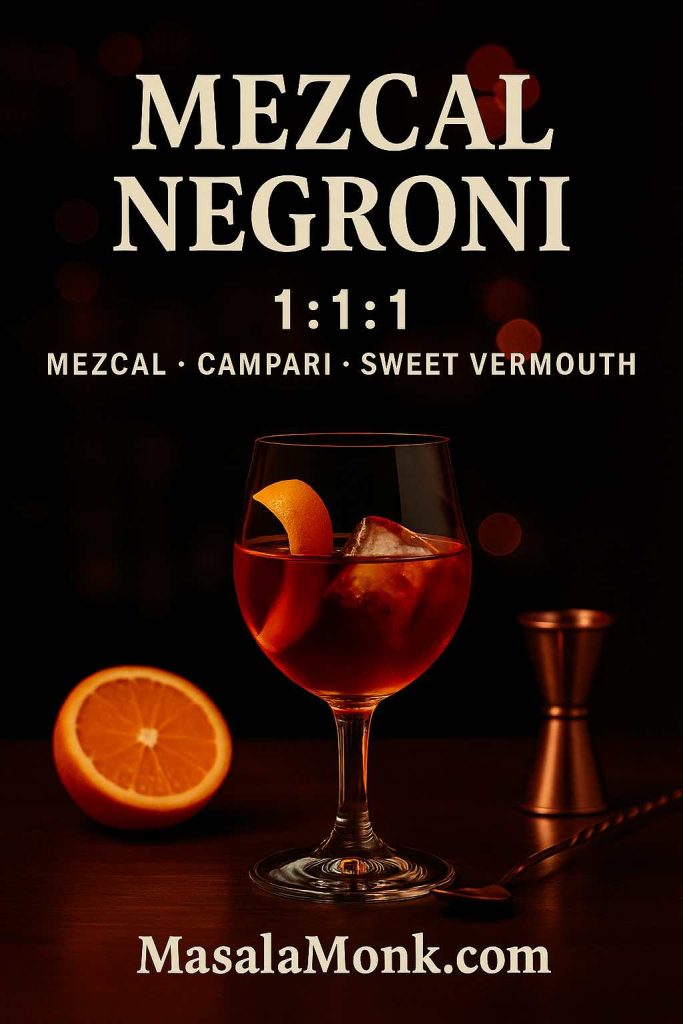
Because mezcal styles vary, try a few and note how fruit, smoke, and mineral tones shift your results. Additionally, reserve the heavily smoky bottles for slow sips; a medium-smoke mezcal usually integrates more gracefully here.
Also Read: Vodka with Lemon: Easy Cocktails, Martini Twist & DIY Infusion
Negroni Sbagliato (with prosecco) and the Negroni Spritz Recipe
Replace gin with sparkling wine and you get the most famous “happy accident” in aperitivo history. The story is irresistible: in 1972 at Bar Basso in Milan, Mirko Stocchetto reportedly grabbed sparkling wine instead of gin, and the Sbagliato (“mistaken”) was born. For an engaging origin sketch, La Cucina Italiana has a succinct explainer; you’ll also find a clear, modern build in Bon Appétit’s recipe. Read more here: Sbagliato’s Milanese origin and this approachable recipe with context.
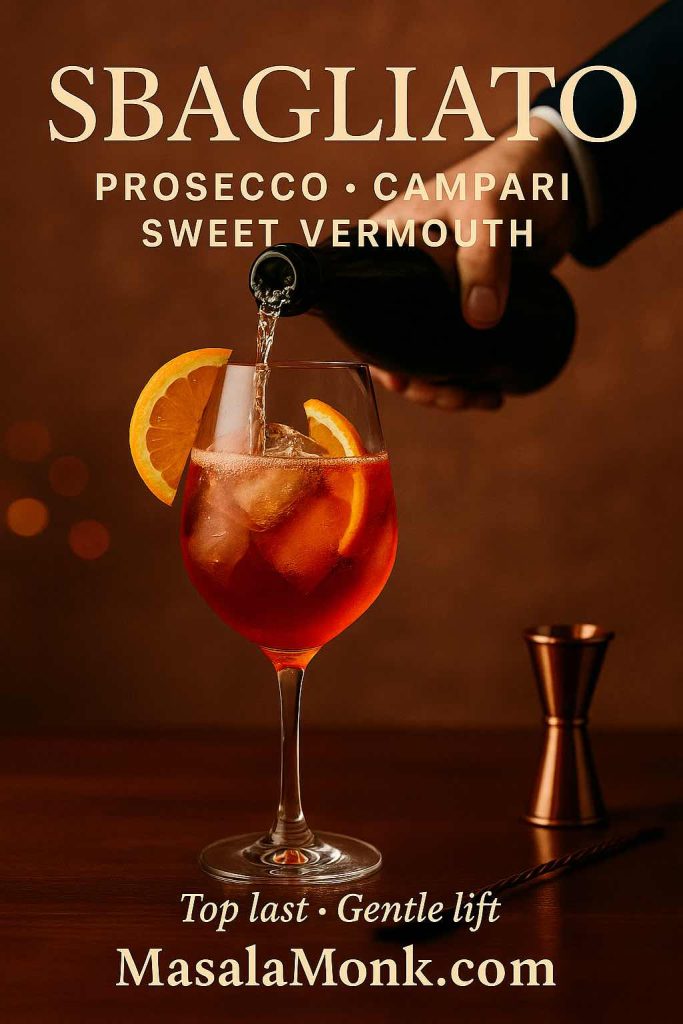
Sbagliato (built, not stirred): In a wine glass full of fresh ice, add 30 ml (1 oz) Campari and 30 ml (1 oz) sweet vermouth, then top with 60–90 ml (2–3 oz) well-chilled prosecco. Give a single gentle lift with the barspoon to marry, garnish with an orange slice, and serve immediately. Because bubbles are fragile, add sparkling last; shaking or stirring vigorously robs you of the lively texture you came for.
Negroni Spritz: If you want something loftier but closer to the classic, build the equal-parts Negroni over ice in a large wine glass, then top with ~60 ml prosecco and ~30 ml cold soda water. One soft lift is plenty. If you enjoy batched spritzes for a crowd—and you like the “sparkling last” principle shown in our party-friendly builds—take a peek at our prosecco-topped structure inside this playful spritz how-to (the principles translate cleanly): a mango-spritz template that stresses topping gently.
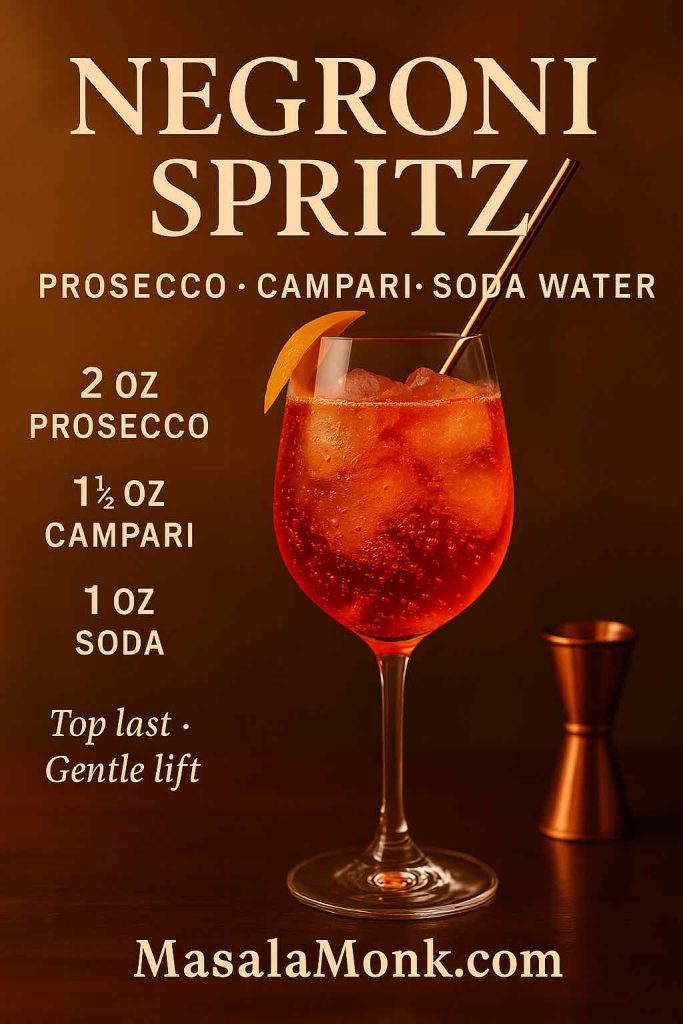
While you’re exploring bubbly builds, another MasalaMonk post shows the same logic for highballs and batched drinks—add the carbonated element at the end to protect fizz—catch the pattern in this breezy guide: Apple Juice Mocktails that sparkle.
Boulevardier / Whiskey–Bourbon–Scotch Negroni (comforting and plush)
Think of the Boulevardier as the Negroni’s whiskey-warm cousin. The IBA standard tilts the ratio to give whiskey a touch more runway.
IBA Spec: 45 ml (1½ oz) bourbon or rye · 30 ml (1 oz) Campari · 30 ml (1 oz) sweet vermouth
Method: Stir over ice; strain up into a chilled stem or over a large cube in a rocks glass; orange zest. The official spec is listed on the IBA’s page: read the Boulevardier entry.

Alternatively, some bartenders push it to 2:1:1 for a richer, rounder sip, while older sources document equal-parts versions. If you like historiography and ratio nerdery, the Wikipedia page collects those threads succinctly: Boulevardier background and ratios.
Fans of whiskey who want other, longer formats to alternate with the Boulevardier often enjoy gently spiced, tea-based highballs or soda-brightened builds—taste that bridge in our cinnamon-spiced whiskey iced-tea guide: Whiskey and Warmth.
Rum Negroni & Kingston Negroni Recipe (island bassline, bitters singing on top)
Rum Negronis aren’t just “the same but sweeter.” Jamaican rum’s esters—ripe banana, molasses funk, overripe pineapple—recast Campari’s bitterness in technicolor. Equal parts will work beautifully with a moderately funky rum; with big-shouldered bottles, a heavier base can be satisfying.
Rum Negroni (balanced): 30 ml (1 oz) Jamaican rum · 30 ml (1 oz) Campari · 30 ml (1 oz) sweet vermouth
Kingston Negroni (cult favorite): 30 ml (1 oz) Smith & Cross (or similar) · 30 ml (1 oz) Campari · 30 ml (1 oz) sweet vermouth; long orange peel.
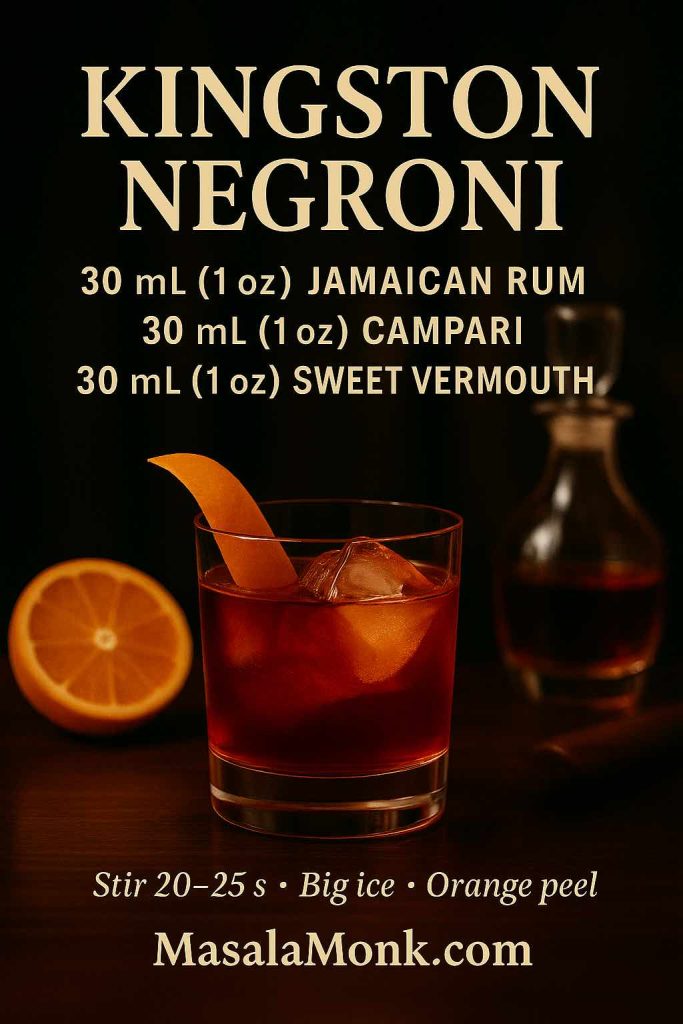
For a lively deep-dive that blind-tastes Kingston variations—including a conversation with the drink’s creator—pour yourself a read at PUNCH: the ultimate Kingston Negroni test and, when you’re ready to mix, grab a clean spec from their recipe card: Kingston Negroni recipe.
If your home bar already leans into rum and citrus, detours like frozen daiquiris or tropical long drinks make a fun next stop; start here for a bright blender template that respects balance: Watermelon Daiquiri.
Espresso Negroni Recipe (coffee bitterness meets Campari snap)
Coffee’s roasted bitterness loves Campari, and a measured splash of espresso folds in seamlessly without swallowing the drink whole. Done right, the result tastes like dark chocolate and orange peel decided to collaborate.
Spec (stirred-friendly): 30 ml (1 oz) gin · 25–30 ml Campari · 15–20 ml sweet vermouth · 10–15 ml fresh, cooled espresso
Method: If using hot espresso, “whip-shake” briefly with a single cube purely to chill and texture, then strain over a large cube; or stir if your espresso is already cold. Express orange peel.

Because technique drives texture here, you’ll get better crema and balance if you borrow a few ideas from our espresso cocktail guides—fast ratio checks, squeeze-time on the shake, and ways to keep the coffee aromatic rather than harsh. Skim both our bar-tested roundups for practical, no-nonsense tips: 10 Best Espresso Martini Variations and these 5 Spiced Espresso Martini Ideas. For a short coffee fundamentals refresher, this quick overview gives you context on extraction and strength: Know Your Coffee.
If you prefer a lighter coffee touch on weeknights, try splitting the espresso with a measured dash of coffee liqueur. The liqueur’s sugar reins in bitterness and creates a silkier seam from sip to finish.
Also Read: What to Mix with Jim Beam: Best Mixers & Easy Cocktails
How to make Dry Negroni & its Recipe for crisper profile, leaner sweetness
Swapping dry vermouth for sweet brings the drink into aperitif-Martini territory—still vivid and bitter, just brighter and more linear. An extra dash or two of orange bitters restores a little mid-palate depth without changing the drink’s posture.
Spec: 30 ml (1 oz) gin · 30 ml (1 oz) Campari · 30 ml (1 oz) dry vermouth
Method: Stir cold, strain, express orange.
Optional: 1–2 dashes orange bitters.
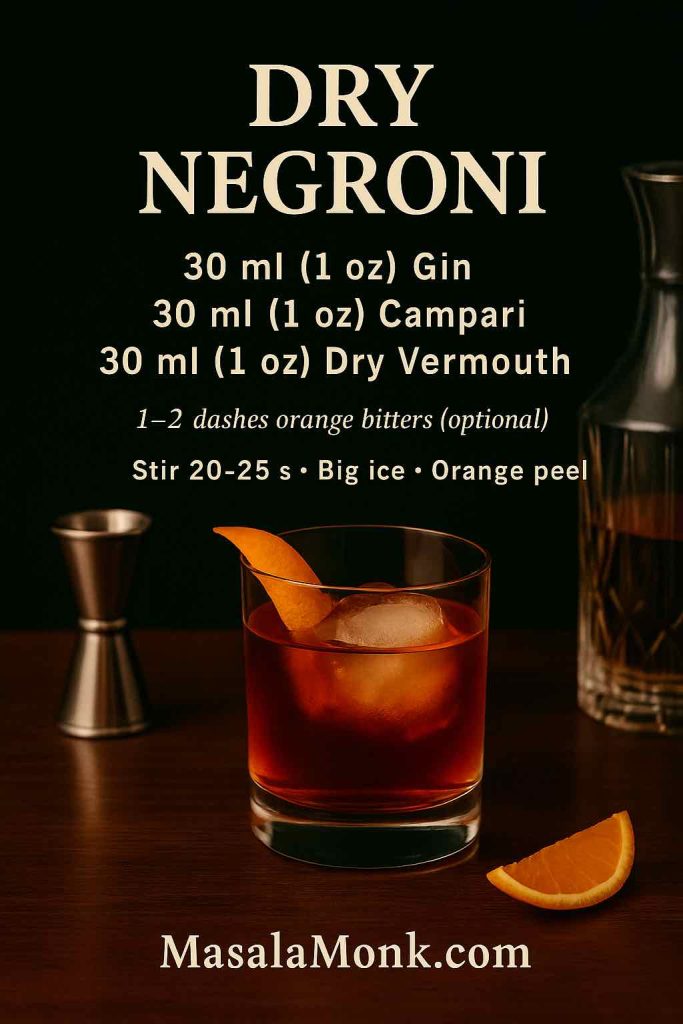
This is the version to pour when the afternoon sun is still warm and you want refreshment over richness. Incidentally, it’s also where gin choice is most obvious: London Dry frames Campari rigidly; softer contemporary gins give you a more perfumed glide.
Also Read: Homemade Hot Chocolate with Cocoa Powder Recipe
Bianco Negroni (clear and citrus-forward)
Think of this as a sibling to the White, but with a bianco vermouth plus a clear bitter (for example, Luxardo Bitter Bianco). The result is translucent, citrus-polished, and perfect when you want something crystalline rather than ruby.
Spec: 30 ml (1 oz) gin · 30 ml (1 oz) bianco vermouth · 30 ml (1 oz) bitter bianco
Method: Stir, serve up or down; garnish with a lemon twist for cleaner aromatics.
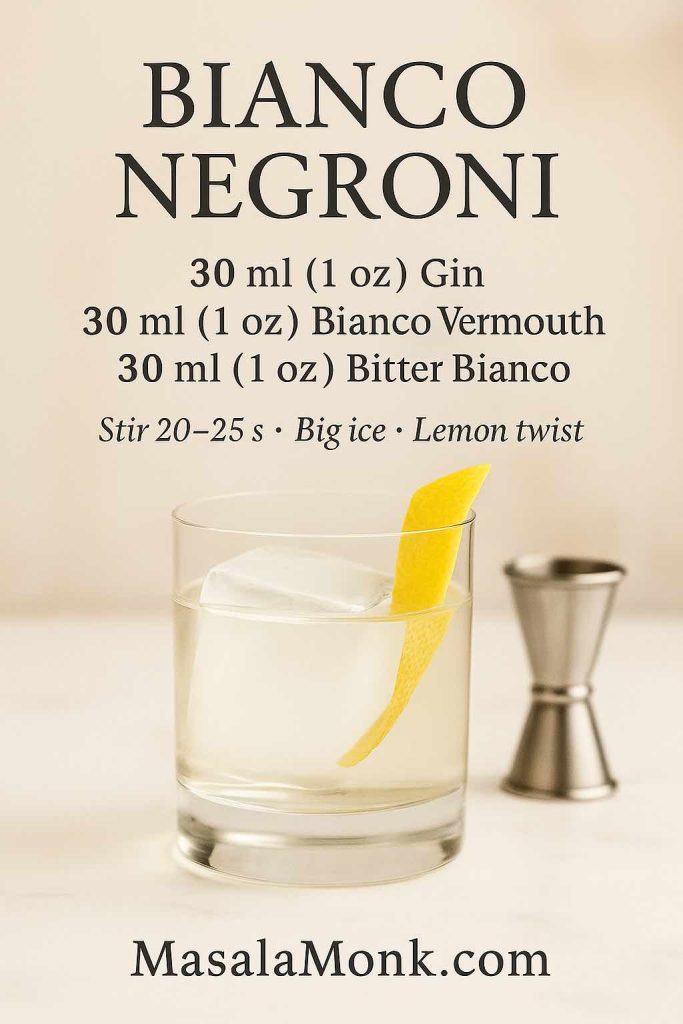
Also Read: Peanut Butter Cookies (Classic Recipe & 3 Variations)
Blood Orange Negroni Recipe (seasonal color, softer bitterness)
When blood oranges are in season, a tiny splash of fresh juice makes your Negroni glow and rounds the Campari edge without turning the drink into a sour.
Spec: 30 ml (1 oz) gin · 25 ml Campari · 25 ml sweet vermouth · 10 ml blood orange juice
Method: Stir and strain over a cube; garnish with a thin wheel or a neat peel.

Notably, this is one of the few moments when a squeeze of juice complements the formula without remaking it from scratch. It’s also a pretty pour for a party tray.
Also Read: Green Tea Shot with Jameson | Recipe & 10 Variations
Recipe of Smoked or Smoky Negroni (aroma as garnish, not a mask)
Smoke can be layered two ways: either lightly smoke the glass (a quick pass of smoldering wood chips before you pour) or introduce a trace of smokiness via a spirit split—say, a teaspoon or two of lightly peated Scotch in the base. Either route preserves the Negroni’s structure but adds a campfire whisper that plays beautifully with orange peel.
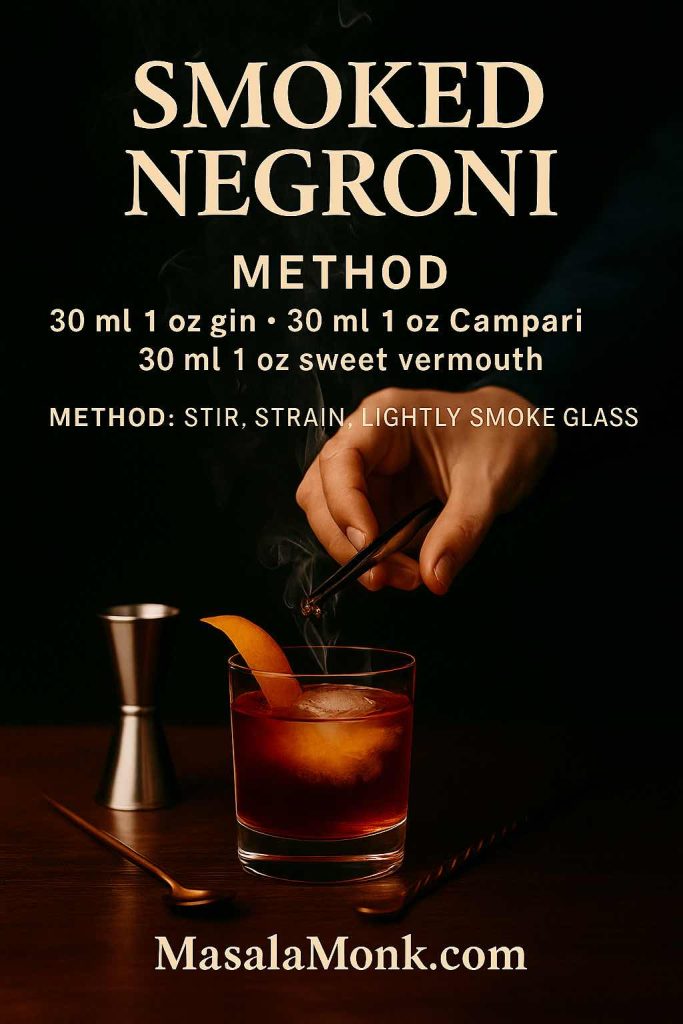
Sour Negroni Recipe (niche, but increasingly asked for)
Add lemon juice and a touch of simple syrup and you shift into sour territory. When you want that texture—especially with a fluffy egg-white cap—the result is closer to a bitter New York Sour than a strict Negroni, but it satisfies the same craving and turns Campari into the star of the foam.
Spec (shaken): 30 ml (1 oz) gin · 22.5 ml (¾ oz) Campari · 22.5 ml (¾ oz) sweet vermouth · 22.5 ml (¾ oz) lemon juice · 7.5 ml (¼ oz) simple syrup
Method: Shake hard; strain into a rocks or a chilled coupe; optional egg white for a glossy cap; orange zest on top.
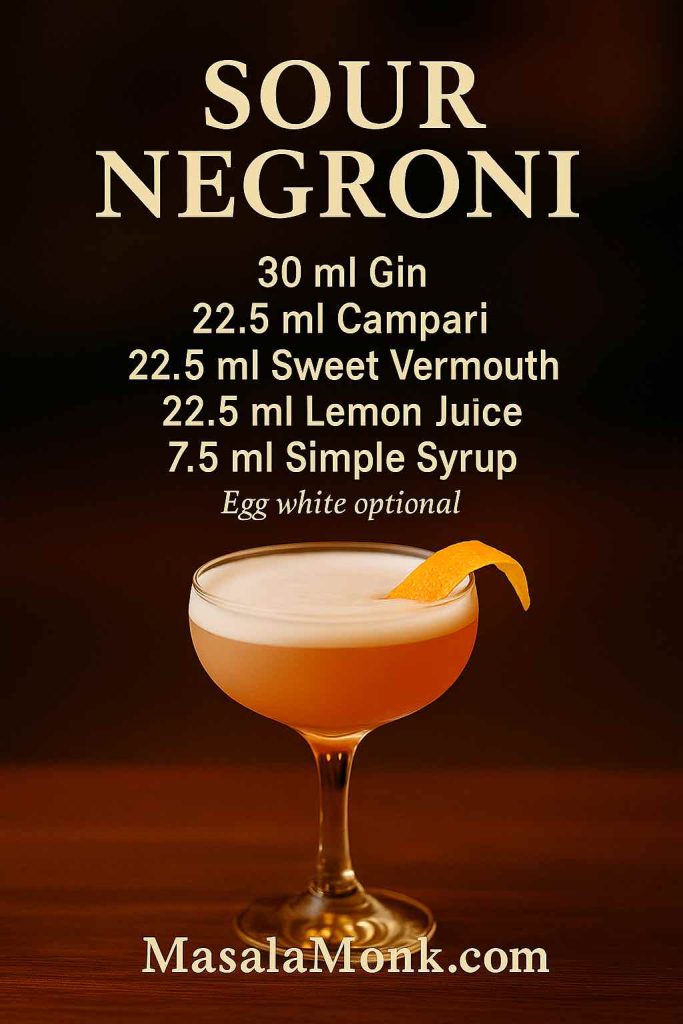
Also Read: Béchamel Sauce for Lasagna: Classic, Vegan & Ricotta Sauce Recipe
Negroni Recipe, built for a crowd (how to prep, mix, and keep it bright)
When you’re pouring for more than two, the Negroni becomes a gift: the equal-parts math scales elegantly, and the drink can be batched in advance. Here’s how to do it without sacrificing texture.
Mix in advance, chill deeply:
Combine gin, Campari, and vermouth in a sealable bottle or pitcher and refrigerate until very cold. If you’re serving up (no ice in the glass), you can add measured cold water to emulate the dilution you’d get from stirring—stirred drinks commonly benefit from about a fifth to a quarter of their volume as water. For a succinct overview of dilution and batching logic, Serious Eats’ guides on party cocktails are useful starting points; you’ll also see the same “sparkling last” principle echoed across spritz articles on our site (for example, the build notes inside this Lemon Drop Martini batching tip). For your bubbly riffs, add prosecco and soda right before serving—never earlier—so the texture is lively in the glass.
Freeze-door Negroni:
If freezer door space is available, pre-dilute the batch slightly with filtered water, then store the bottle in the freezer. The drink pours velvety and ice-cold straight from the bottle; one large cube in the glass will keep it on track without over-thinning. And yes, big, clear cubes help more than you’d think; revisit our practical note on intentional ice in Coconut Water Cocktails.
Party tray service:
Express your peels in advance and hold them wrapped to prevent drying. When guests arrive, all you’re doing is pour-and-garnish. If you’d like to offer a bubbly option side-by-side, pre-batch the Campari and vermouth in a separate bottle for Sbagliatos, then top each glass with prosecco to order. For an easy visual, see how we structure spritzes and highballs in our sparkling pieces—always top last and lift once (you’ll spot the same advice in our spritz-centric posts like Apple Juice Mocktails and that breezy Mango Spritz template).
How ingredients change the drink (and how to choose them)
Because “gin + Campari + vermouth” can be millions of combinations, a few guidelines keep you oriented.
Gin:
A classic London Dry (Beefeater, Tanqueray, etc.) slots in cleanly with Campari’s decisive bitterness, producing what most people expect when they order a Negroni. Contemporary gins—grapefruit-peel bright, cucumber-cool, or floral—shift the balance toward perfume and away from juniper’s structure. Consequently, they’re a joy in White/Bianco families and dry variants; with standard ruby Negronis, you may want to keep them in supporting or split-base roles.
Vermouth:
Freshness is everything. Even the best bottle tastes sleepy after a long, warm month on the shelf. To keep your drinks crisp, store rosso and bianco vermouths cold and pick a bottle size that matches your cadence. For a clear, evidence-based nudge, peek at that Serious Eats test again: refrigeration keeps vermouth tasting like itself. To triangulate the practical window you can work with, Liquor.com’s shelf-life guide suggests ~6–8 weeks as an upper, real-world bound: how long vermouth lasts once opened.
Campari and its cousins:
Campari is the reference point. That said, regional bitters or boutique red amaros will nudge the edges and can be wonderful; just expect the sweetness and bitterness to rebalance slightly and adjust your vermouth choice to harmonize.
Citrus:
Orange is canonical, but lemon can be elegant in White/Bianco builds. With blood orange riffs, you might even split the garnish—express an orange twist, then place a thin blood orange wheel as a visual cue.
Coffee:
If you’re already dialing in coffee for other cocktails, keep that wisdom in rotation. Our espresso pieces walk through real ratios, foam/crema physics, and the difference between moka, espresso, and cold brew—handy context before you tweak the Espresso Negroni: Bar-tested variations and spiced espresso ideas.
Tea & spice:
For aromatic spin without extra sugar, tea-infused elements are gentle tools. A touch of bergamot from Earl Grey feels tailor-made for the White Negroni; if that sounds like your lane, the iced-tea cocktail shortlist we mentioned earlier includes an Earl Grey Negroni idea.
Also Read: Crock Pot Lasagna Soup (Easy Base + Cozy Slow-Cooker Recipes)
Negroni Recipe variations you can learn in one sitting (quick cards)
Because the best way to remember is to make and taste, here’s a compact set you can practice in an afternoon. They’re concise by design; each will teach your palate something distinct about how bitterness, sweetness, and aroma negotiate with one another.
Classic (equal parts, stirred)
30 ml (1 oz) gin · 30 ml (1 oz) Campari · 30 ml (1 oz) sweet vermouth · orange peel
White Negroni (equal parts)
30 ml (1 oz) gin · 30 ml (1 oz) Suze · 30 ml (1 oz) Lillet Blanc or Cocchi Americano · grapefruit peel
Background and context: WSET’s Negroni reinventions
Mezcal Negroni
30 ml (1 oz) mezcal · 30 ml (1 oz) Campari · 30 ml (1 oz) sweet vermouth · orange peel
Sbagliato (built)
30 ml (1 oz) Campari · 30 ml (1 oz) sweet vermouth · top 60–90 ml prosecco · orange slice
Story and recipe: Milan’s Sbagliato origin and a clear, modern build
Negroni Spritz (built)
Classic equal-parts over ice · top prosecco (~60 ml) · splash soda (~30 ml) · gentle lift
For bubbly logic you can reuse in other spritzes: Apple Juice Mocktails and this party-friendly Mango Spritz template
Boulevardier (stirred)
45 ml (1½ oz) bourbon or rye · 30 ml (1 oz) Campari · 30 ml (1 oz) sweet vermouth · orange zest
Official spec: IBA Boulevardier and additional ratio notes: background & variations
Rum / Kingston Negroni (stirred)
30 ml (1 oz) Jamaican rum · 30 ml (1 oz) Campari · 30 ml (1 oz) sweet vermouth · long orange peel
Deep-dive + recipe: Ultimate Kingston test and recipe card
Espresso Negroni (stir or quick whip)
30 ml (1 oz) gin · 25–30 ml Campari · 15–20 ml sweet vermouth · 10–15 ml espresso · orange peel
Technique primers: Bar-tested espresso ratios and spiced riffs
Dry Negroni (stirred)
30 ml (1 oz) gin · 30 ml (1 oz) Campari · 30 ml (1 oz) dry vermouth · optional orange bitters
Bianco Negroni (stirred)
30 ml (1 oz) gin · 30 ml (1 oz) bianco vermouth · 30 ml (1 oz) bitter bianco · lemon twist
Blood Orange Negroni (stirred)
30 ml (1 oz) gin · 25 ml Campari · 25 ml sweet vermouth · 10 ml blood orange juice
Smoked Negroni (stirred, smoked glass or spirit split)
Classic spec; smoke the glass briefly or split the base with a teaspoon of lightly peated Scotch
Sour Negroni (shaken)
30 ml gin · 22.5 ml Campari · 22.5 ml sweet vermouth · 22.5 ml lemon juice · 7.5 ml simple · optional egg white
Also Read: How to Make Churros (Authentic + Easy Recipe)
Negroni Recipe troubleshooting (without losing the magic)
Even with three ingredients, small missteps can blur the drink. Here’s how to fix the most common issues while keeping the Negroni’s essential profile intact.
“It tastes too bitter.” Two easy adjustments: (1) increase vermouth slightly to 35 ml (1⅙ oz) while pulling Campari back to 25 ml (5⁄6 oz), or (2) express a larger piece of orange peel and drag it around the rim—a simple aroma trick that smooths the edges. On very hot days, serving down over a larger cube helps too, since slower melt equals steadier sweetness perception.
“It’s thin or watery.” Start with colder bottles. Then, shorten your stir by a few seconds and use denser ice. If you’re nursing the drink outdoors, consider a chilled double rocks glass.
“It’s too sweet.” Verify your vermouth freshness first; oxidized bottles can taste oddly fat and dull. If freshness checks out, try a slightly drier ratio—32 ml gin, 28 ml Campari, 28 ml vermouth—or move to the Dry Negroni template with a dash or two of orange bitters.
“The coffee note in my Espresso Negroni turned harsh.” Cool the espresso before it hits alcohol or add a measured dash of coffee liqueur to buffer any roughness. For texture, borrow espresso-martini tricks from our guides so your shake is purposeful, not violent: 10 Best Espresso Martini Variations and spiced espresso ideas.
“My Sbagliato/Spritz goes flat.” Top with prosecco last and give one gentle lift; this is the through-line in every sparkling build we publish, from zero-proof spritzes to party punches—notice the same sequencing in our Apple Mocktails and the Mango Spritz template. For origin and a modern, field-tested Sbagliato spec, revisit La Cucina Italiana and Bon Appétit.
Also Read: Classic vs. Authentic Alfredo: 5 Essential Recipes
Where your Negroni sits in the canon (and why that matters)
Part of the pleasure of mastering a Negroni recipe is discovering its cousins and context. Historically, this family arises from the Americano (bitter + sweet + soda), which the Negroni toughens by swapping soda for gin. Down the tree, the Boulevardier warms it with whiskey; sideways, the Sbagliato relaxes it with bubbles. It holds a proud spot on the IBA’s roster of classics: see the Negroni’s official entry and the Boulevardier’s page. As you taste across the set, you’ll feel how alcohol strength, sugar, and bitterness move as a triangle—nudge one point and the other two respond. That mental model makes you a faster, calmer host because you’ll instinctively know how to correct a drink mid-stream.
Moreover, when your bar cart evolves, your Negroni will evolve with it. If you have a contemporary gin that smells like lemon zest and flowers, it might shine in a Bianco lane; a juniper-spicy London Dry might feel exactly right in the classic ruby build; a bottle of Jamaican rum waiting for its moment is practically begging for a Kingston test flight. Should you be deep in a whiskey season, the Boulevardier keeps that glow going, and our gentle whiskey highballs are there when you want something longer: Whiskey and Warmth.
Finally, because tools and technique are part of the pleasure, keep one eye on the small details that compound: cold bottles, large clear ice, and confidently expressed citrus. Tiny changes, cumulative gains. For a quick pep talk on ice’s role across cocktail styles, revisit the practical notes we tucked into Coconut Water Cocktails.
One last round (and what to explore next)
At this point you can pour the Negroni recipe from muscle memory: equal parts, stirred, orange oils. You can also steer by instinct—toward gentian brightness in a White Negroni; toward smoke under a Mezcal Negroni; toward bubbles in a Sbagliato or Negroni Spritz; toward warmth in a Boulevardier; toward island aromatics with the Kingston; toward roast and chocolate in an Espresso Negroni; or toward crispness with a Dry or Bianco build. Along the way, you learned how to keep vermouth fresh (why the fridge matters, plus a practical window), how to protect bubbles (top last, lift once), and how ice behaves from the first stir to the last sip.
If you’re in the mood to keep exploring tonight, let your palate choose the fork: a tea-scented Earl Grey Negroni idea awaits in our iced-tea collection (Earl Grey Elegance); a coffee-obsessed detour is ready in our espresso pieces (bar-tested ratios and warming spice riffs); and if you’d like to set up a spritz station for friends, our prosecco-topped builds show you exactly how to do it without losing fizz (Apple Mocktails and the Mango Spritz template).
Whichever path you pick, you’re bringing the Negroni’s spirit with you: balance, clarity, and a little ceremony. Raise the glass, take in the orange oils, and sip slowly—the night will meet you there.
Also Read: 10 Best Chicken Sandwich Recipes (BBQ, Parm, Buffalo & More)
FAQs
1) What is the classic Negroni Recipe ratio?
The classic Negroni Recipe follows a simple 1:1:1 formula—equal parts gin, Campari, and sweet (rosso) vermouth—stirred over ice and finished with an expressed orange peel.
2) How do you make a Negroni Recipe step by step?
Measure 30 ml (1 oz) each of gin, Campari, and sweet vermouth into a mixing glass with plenty of cold ice. Stir 20–25 seconds until well-chilled, strain over a large cube in a rocks glass, then express and drop in an orange peel.
3) Should a Negroni be stirred or shaken?
Always stir a Negroni Recipe. Stirring chills and dilutes precisely while keeping the drink clear and silky; shaking aerates and can over-dilute.
4) Which gin is best for a Negroni Recipe?
Choose a juniper-forward London Dry for the most “classic” profile. Alternatively, contemporary gins (citrus-forward or floral) soften edges and shine in White/Bianco or Dry Negroni variations.
5) What vermouth works best in a Negroni Recipe?
Use a fresh, high-quality sweet (rosso) vermouth for the classic. Keep it refrigerated after opening and aim to finish the bottle within a few weeks for peak flavor.
6) Can I make a Negroni Recipe with dry vermouth?
Yes—swap sweet vermouth for dry to create a Dry Negroni. Optionally add 1–2 dashes of orange bitters to restore mid-palate depth.
7) What’s the difference between a White Negroni and a Bianco Negroni?
A White Negroni typically uses gin, Suze (gentian bitter), and Lillet Blanc or Cocchi Americano. A Bianco Negroni uses gin, bianco vermouth, and a clear bitter (e.g., Bitter Bianco); it’s crisper and more citrus-forward.
8) How do I make a Mezcal Negroni?
Combine equal parts mezcal, Campari, and sweet vermouth, then stir and serve over a large cube with orange peel. For gentler smoke, split the base: 20 ml mezcal + 10 ml gin.
9) What is a Negroni Sbagliato and how is it different?
A Sbagliato replaces gin with prosecco. Build Campari and sweet vermouth over ice, then top with chilled prosecco. It’s lighter, bubbly, and lower in ABV than the classic Negroni Recipe.
10) How is a Negroni Spritz built?
Start with the classic equal parts over ice in a large wine glass, then top with prosecco and a splash of soda water. Give one gentle lift to preserve bubbles.
11) Is a Boulevardier just a Negroni with whiskey?
Essentially, yes. A Boulevardier swaps gin for bourbon or rye (often in a 1½:1:1 ratio). Stir, strain, and garnish with orange zest.
12) Can I make a Rum Negroni or Kingston Negroni?
Absolutely. Use equal parts Jamaican rum, Campari, and sweet vermouth for a Rum Negroni; choose a high-ester rum for the Kingston style to highlight tropical aromatics.
13) How do I make an Espresso Negroni?
Add a small measure of fresh espresso (10–15 ml) to the classic, then stir—or briefly “whip-shake” to chill and create light crema. Express orange to link coffee and Campari.
14) What if I don’t have vermouth—can I still do a Negroni Recipe?
You can approximate by using amaro or aperitif wines, but the flavor balance will change. If vermouth is missing, consider a different cocktail or lean into a Dry Negroni style with dry vermouth if that’s on hand.
15) Can I make a Negroni Recipe without Campari?
You can substitute another red bitter or amaro, understanding sweetness and bitterness may shift. Start with equal parts and adjust vermouth to balance.
16) What garnish is proper for a Negroni Recipe?
A wide orange peel, expressed over the surface to release oils. For White/Bianco versions, a grapefruit or lemon twist suits the profile beautifully.
17) How strong is a Negroni?
Served over ice, the Negroni Recipe typically lands around the mid-20% ABV range after dilution. Strength varies with spirit proof, ice, and stir time.
18) Why does my Negroni taste too bitter?
First, check ratios. Then, try a slightly vermouth-forward balance (e.g., 35 ml vermouth, 25 ml Campari) or express a larger orange peel. Warmer drinks feel harsher, so keep everything very cold.
19) Why does my Negroni taste watery?
Either your ice is melting too fast or you’re over-stirring. Use dense, large cubes and shorten the stir by a few seconds. Pre-chill glassware when possible.
20) How do I batch a Negroni Recipe for parties?
Multiply equal parts gin, Campari, and vermouth, bottle, and chill deeply. If serving up, pre-dilute with cold filtered water (≈20–25% of total volume). Add any sparkling components (for Sbagliato/Spritz) right before serving.
21) Can I store a pre-mixed Negroni in the fridge or freezer?
Yes. A pre-diluted, bottled Negroni can live in the freezer for service “from the door.” If it’s undiluted, keep it in the fridge and stir to order with fresh ice.
22) What glass is best for a Negroni Recipe?
A heavy rocks glass with one large cube is standard. For the Sbagliato and Spritz, a large wine glass accommodates bubbles and garnish more comfortably.
23) Does the type of ice really matter?
Definitely. Large, clear cubes melt slower and keep flavors focused. Crushed or small cubes chill quickly but dilute faster, which can blur balance.
24) What’s the ideal stir time for a Negroni Recipe?
About 20–25 seconds with cold, dense ice. Look for a glossy texture and a frosty mixing glass rather than counting alone.
25) Is there a “perfect” Negroni Recipe beyond 1:1:1?
Equal parts is canonical, yet many bartenders enjoy tiny tweaks—more base spirit for a drier finish or a touch more vermouth to soften bitterness. Adjust in 5 ml (¼ oz) steps.
26) Which bitters can I add to a Negroni?
Orange bitters fold in nicely, particularly in a Dry Negroni. Chocolate or coffee bitters are delicious with espresso riffs; use sparingly.
27) Can I use Bianco vermouth in a classic Negroni Recipe?
Yes, though it pushes the drink toward the Bianco style—brighter, clearer, and a bit lighter in perceived sweetness. Consider a lemon twist instead of orange.
28) How do seasonal citrus swaps change a Negroni?
Blood orange juice (a small splash) softens bitterness and adds color; grapefruit peels add floral lift to White/Bianco versions. Keep juice additions modest to avoid turning the drink into a sour.
29) What’s the difference between a Negroni Spritz and a Sbagliato?
Both are bubbly, but the Spritz keeps the gin (then tops with prosecco and soda), while the Sbagliato replaces gin entirely with prosecco. The Spritz is brighter; the Sbagliato is softer and lower in ABV.
30) Can I make a non-alcoholic Negroni?
Yes. Combine equal parts non-alcoholic “gin,” NA red bitter, and NA aperitivo/rosso. Serve extra-cold; a few drops of saline solution can improve body.
31) Does glassware temperature affect the Negroni Recipe?
Chilled glassware helps maintain temperature and texture, especially for up-style service or hot-weather pours. It’s a small step with big payoff.
32) What’s the quickest way to upgrade my home Negroni?
Use fresh, refrigerated vermouth; cut a wide, juicy orange peel; and stir with dense ice over a single large cube. Those three changes deliver a bar-quality result.
33) How do I keep a Sbagliato or Spritz from going flat?
Add prosecco (and soda, if using) at the very end. Stir gently—one light lift is enough—to avoid knocking out carbonation.
34) Is a Negroni Recipe good for batching in a pitcher?
Absolutely. The equal-parts structure scales cleanly. Keep the pitcher ice-cold, stir portions over fresh ice for service, and garnish each glass individually.
35) Why is my Espresso Negroni harsh or muddy?
Hot espresso hitting alcohol can taste sharp. Cool it briefly, use a small measure, or split with a touch of coffee liqueur. Finally, express orange peel to link flavors.
36) Can I use flavored gins in a Negroni Recipe?
You can, though they may introduce sweetness or botanicals that clash with Campari. If you experiment, start with small test pours and consider the Dry or Bianco frameworks.
37) What peel size is best for expressing oils?
A wide strip (about 2–3 cm wide) expressed over the surface releases more aromatic oil. Avoid pith-heavy strips, which can add bitterness.
38) How long should a batched Negroni Recipe keep?
If kept cold and sealed, spirit-forward batches (without juice) hold well for weeks. However, quality is highest in the first week, especially when vermouth is freshest.
39) Can I turn a Negroni into a sour-style cocktail?
Yes—add lemon juice and a little syrup, then shake hard. Optionally include egg white for a velvety cap; garnish with orange zest to anchor Campari’s citrus.
40) What’s the simplest variation to try after the classic?
Try the White Negroni if you want brightness, the Boulevardier for warmth, the Kingston for tropical depth, or the Espresso Negroni for roast-and-orange harmony. Each teaches a distinct lesson while honoring the spirit of the original.

